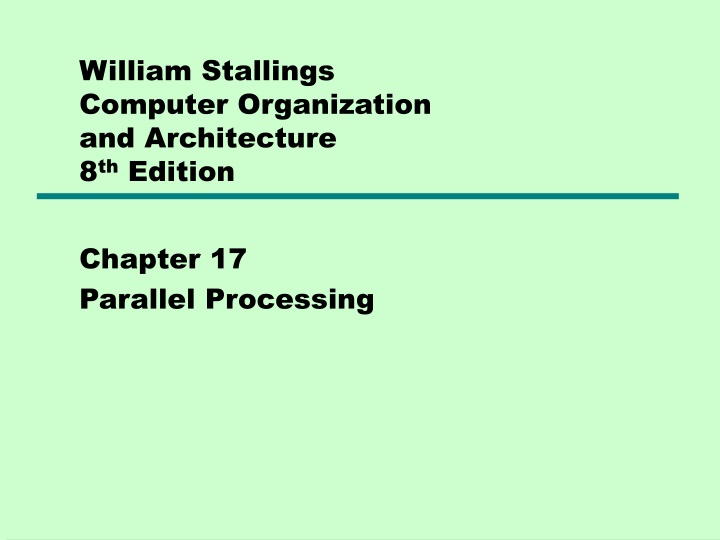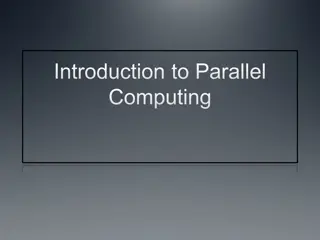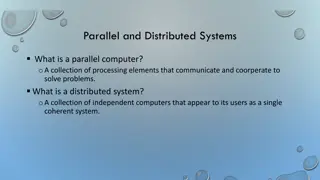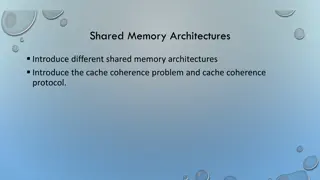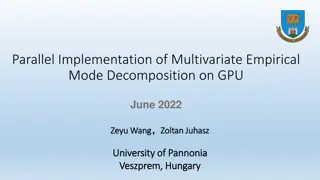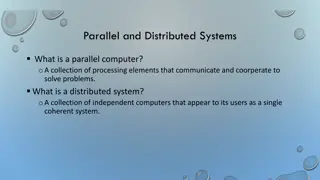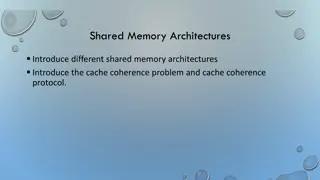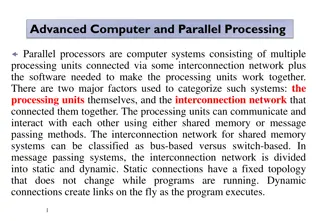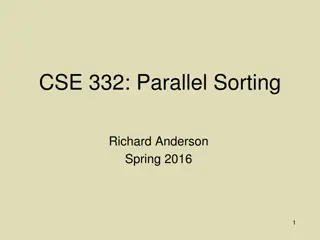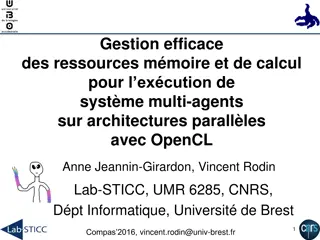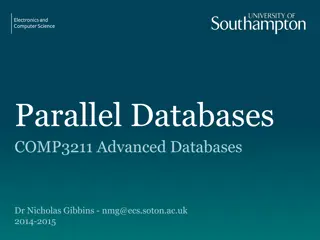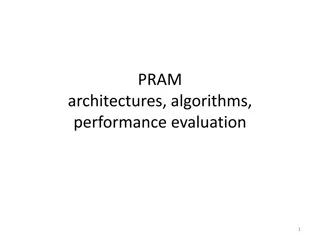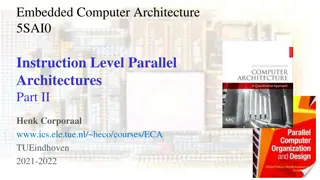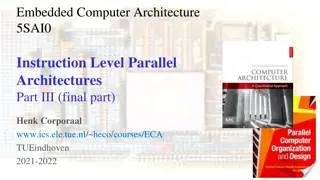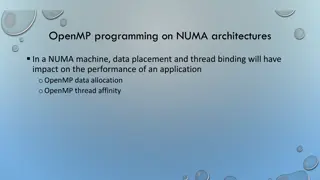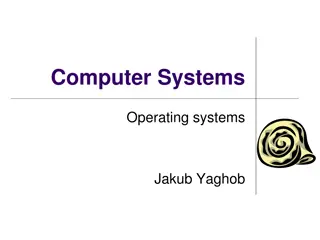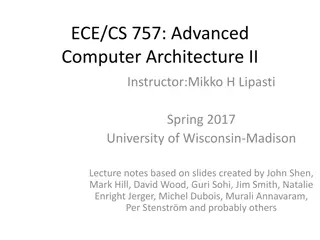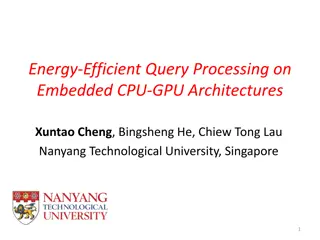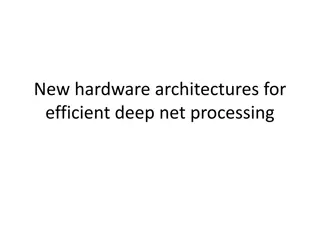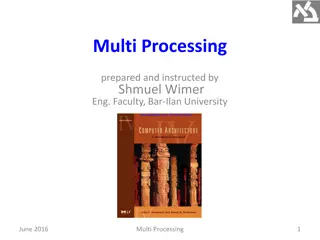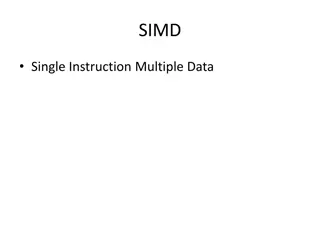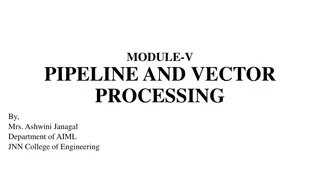Overview of Parallel Processing Architectures
This comprehensive overview delves into the taxonomy of parallel processor architectures, including SISD, SIMD, MISD, and MIMD configurations. It explores the characteristics of each architecture type, such as single vs. multiple instruction streams and data streams. The images provided visually represent the concepts discussed, offering a clear understanding of parallel processing principles.
Download Presentation

Please find below an Image/Link to download the presentation.
The content on the website is provided AS IS for your information and personal use only. It may not be sold, licensed, or shared on other websites without obtaining consent from the author.If you encounter any issues during the download, it is possible that the publisher has removed the file from their server.
You are allowed to download the files provided on this website for personal or commercial use, subject to the condition that they are used lawfully. All files are the property of their respective owners.
The content on the website is provided AS IS for your information and personal use only. It may not be sold, licensed, or shared on other websites without obtaining consent from the author.
E N D
Presentation Transcript
William Stallings Computer Organization and Architecture 8thEdition Chapter 17 Parallel Processing
Multiple Processor Organization Single instruction, single data stream - SISD Single instruction, multiple data stream - SIMD Multiple instruction, single data stream - MISD Multiple instruction, multiple data stream- MIMD
Single Instruction, Single Data Stream - SISD Single processor Single instruction stream Data stored in single memory Uni-processor
Single Instruction, Multiple Data Stream - SIMD Single machine instruction Controls simultaneous execution Number of processing elements Lockstep basis Each processing element has associated data memory Each instruction executed on different set of data by different processors Vector and array processors
Multiple Instruction, Single Data Stream - MISD Sequence of data Transmitted to set of processors Each processor executes different instruction sequence Never been implemented
Multiple Instruction, Multiple Data Stream- MIMD Set of processors Simultaneously execute different instruction sequences Different sets of data SMPs, clusters and NUMA systems
Taxonomy of Parallel Processor Architectures
MIMD - Overview General purpose processors Each can process all instructions necessary Further classified by method of processor communication
Tightly Coupled - SMP Processors share memory Communicate via that shared memory Symmetric Multiprocessor (SMP) Share single memory or pool Shared bus to access memory Memory access time to given area of memory is approximately the same for each processor
Tightly Coupled - NUMA Nonuniform memory access Access times to different regions of memory may differ
Loosely Coupled - Clusters Collection of independent uniprocessors or SMPs Interconnected to form a cluster Communication via fixed path or network connections
Parallel Organizations - MIMD Distributed Memory
Symmetric Multiprocessors A stand alone computer with the following characteristics Two or more similar processors of comparable capacity Processors share same memory and I/O Processors are connected by a bus or other internal connection Memory access time is approximately the same for each processor All processors share access to I/O Either through same channels or different channels giving paths to same devices All processors can perform the same functions (hence symmetric) System controlled by integrated operating system providing interaction between processors Interaction at job, task, file and data element levels
SMP Advantages Performance If some work can be done in parallel Availability Since all processors can perform the same functions, failure of a single processor does not halt the system Incremental growth User can enhance performance by adding additional processors Scaling Vendors can offer range of products based on number of processors
Block Diagram of Tightly Coupled Multiprocessor
Organization Classification Time shared or common bus Multiport memory Central control unit
Time Shared Bus Simplest form Structure and interface similar to single processor system Following features provided Addressing - distinguish modules on bus Arbitration - any module can be temporary master Time sharing - if one module has the bus, others must wait and may have to suspend Now have multiple processors as well as multiple I/O modules
Time Share Bus - Advantages Simplicity Flexibility Reliability
Time Share Bus - Disadvantage Performance limited by bus cycle time Each processor should have local cache Reduce number of bus accesses Leads to problems with cache coherence Solved in hardware - see later
Operating System Issues Simultaneous concurrent processes Scheduling Synchronization Memory management Reliability and fault tolerance
A Mainframe SMP IBM zSeries Uniprocessor with one main memory card to a high-end system with 48 processors and 8 memory cards Dual-core processor chip Each includes two identical central processors (CPs) CISC superscalar microprocessor Mostly hardwired, some vertical microcode 256-kB L1 instruction cache and a 256-kB L1 data cache L2 cache 32 MB Clusters of five Each cluster supports eight processors and access to entire main memory space System control element (SCE) Arbitrates system communication Maintains cache coherence Main store control (MSC) Interconnect L2 caches and main memory Memory card Each 32 GB, Maximum 8 , total of 256 GB Interconnect to MSC via synchronous memory interfaces (SMIs) Memory bus adapter (MBA) Interface to I/O channels, go directly to L2 cache
IBM z990 Multiprocessor Structure
Cache Coherence and MESI Protocol Problem - multiple copies of same data in different caches Can result in an inconsistent view of memory Write back policy can lead to inconsistency Write through can also give problems unless caches monitor memory traffic
Software Solutions Compiler and operating system deal with problem Overhead transferred to compile time Design complexity transferred from hardware to software However, software tends to make conservative decisions Inefficient cache utilization Analyze code to determine safe periods for caching shared variables
Hardware Solution Cache coherence protocols Dynamic recognition of potential problems Run time More efficient use of cache Transparent to programmer Directory protocols Snoopy protocols
Directory Protocols Collect and maintain information about copies of data in cache Directory stored in main memory Requests are checked against directory Appropriate transfers are performed Creates central bottleneck Effective in large scale systems with complex interconnection schemes
Snoopy Protocols Distribute cache coherence responsibility among cache controllers Cache recognizes that a line is shared Updates announced to other caches Suited to bus based multiprocessor Increases bus traffic
Write Invalidate Multiple readers, one writer When a write is required, all other caches of the line are invalidated Writing processor then has exclusive (cheap) access until line required by another processor Used in Pentium II and PowerPC systems State of every line is marked as modified, exclusive, shared or invalid MESI
Write Update Multiple readers and writers Updated word is distributed to all other processors Some systems use an adaptive mixture of both solutions
Increasing Performance Processor performance can be measured by the rate at which it executes instructions MIPS rate = f * IPC f processor clock frequency, in MHz IPC is average instructions per cycle Increase performance by increasing clock frequency and increasing instructions that complete during cycle May be reaching limit Complexity Power consumption
Multithreading and Chip Multiprocessors Instruction stream divided into smaller streams (threads) Executed in parallel Wide variety of multithreading designs
Definitions of Threads and Processes Thread in multithreaded processors may or may not be same as software threads Process: An instance of program running on computer Resource ownership Virtual address space to hold process image Scheduling/execution Process switch Thread: dispatchable unit of work within process Includes processor context (which includes the program counter and stack pointer) and data area for stack Thread executes sequentially Interruptible: processor can turn to another thread Thread switch Switching processor between threads within same process Typically less costly than process switch
Implicit and Explicit Multithreading All commercial processors and most experimental ones use explicit multithreading Concurrently execute instructions from different explicit threads Interleave instructions from different threads on shared pipelines or parallel execution on parallel pipelines Implicit multithreading is concurrent execution of multiple threads extracted from single sequential program Implicit threads defined statically by compiler or dynamically by hardware
Approaches to Explicit Multithreading Interleaved Fine-grained Processor deals with two or more thread contexts at a time Switching thread at each clock cycle If thread is blocked it is skipped Blocked Coarse-grained Thread executed until event causes delay E.g.Cache miss Effective on in-order processor Avoids pipeline stall Simultaneous (SMT) Instructions simultaneously issued from multiple threads to execution units of superscalar processor Chip multiprocessing Processor is replicated on a single chip Each processor handles separate threads
Scalar Processor Approaches Single-threaded scalar Simple pipeline No multithreading Interleaved multithreaded scalar Easiest multithreading to implement Switch threads at each clock cycle Pipeline stages kept close to fully occupied Hardware needs to switch thread context between cycles Blocked multithreaded scalar Thread executed until latency event occurs Would stop pipeline Processor switches to another thread
Multiple Instruction Issue Processors (1) Superscalar No multithreading Interleaved multithreading superscalar: Each cycle, as many instructions as possible issued from single thread Delays due to thread switches eliminated Number of instructions issued in cycle limited by dependencies Blocked multithreaded superscalar Instructions from one thread Blocked multithreading used
Multiple Instruction Issue Processors (2) Very long instruction word (VLIW) E.g. IA-64 Multiple instructions in single word Typically constructed by compiler Operations that may be executed in parallel in same word May pad with no-ops Interleaved multithreading VLIW Similar efficiencies to interleaved multithreading on superscalar architecture Blocked multithreaded VLIW Similar efficiencies to blocked multithreading on superscalar architecture
Parallel, Simultaneous Execution of Multiple Threads Simultaneous multithreading Issue multiple instructions at a time One thread may fill all horizontal slots Instructions from two or more threads may be issued With enough threads, can issue maximum number of instructions on each cycle Chip multiprocessor Multiple processors Each has two-issue superscalar processor Each processor is assigned thread Can issue up to two instructions per cycle per thread
Examples Some Pentium 4 Intel calls it hyperthreading SMT with support for two threads Single multithreaded processor, logically two processors IBM Power5 High-end PowerPC Combines chip multiprocessing with SMT Chip has two separate processors Each supporting two threads concurrently using SMT
